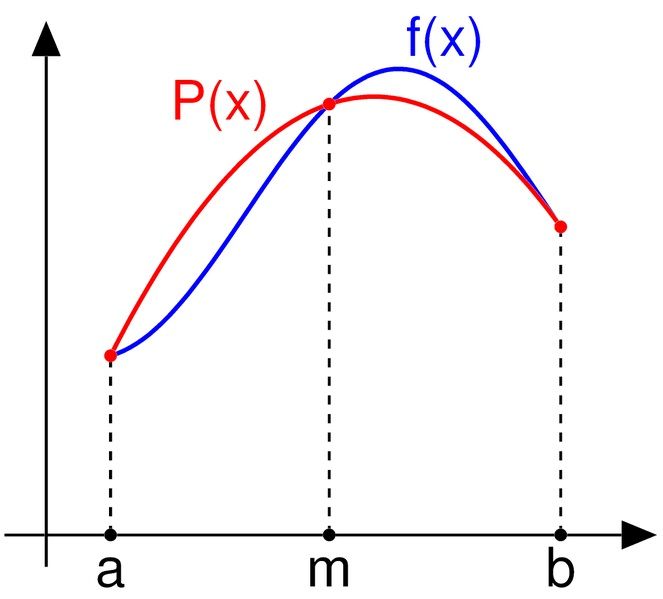How To Use Simpson's Rule

Simpson'south rule is a method for numerical integration. In other words, it's the numerical approximation of definite integrals.
Simpson'southward dominion is equally follows:

In it,
-
f(ten)is called the integrand -
a= lower limit of integration -
b= upper limit of integration
Simpson's 1/3 Dominion

As shown in the diagram in a higher place, the integrand f(10) is approximated past a second order polynomial; the quadratic interpolant being P(ten).
The approximation follows,

Replacing (b-a)/two as h, we get,

Equally you lot can see, in that location is a factor of 1/3 in the above expression. That's why, it is called Simpson's one/3 Dominion .
If a function is highly oscillatory or lacks derivatives at certain points, so the above dominion may fail to produce accurate results.
A common way to handle this is by using the blended Simpson's rule arroyo. To do this, break upward [a,b] into pocket-sized subintervals, so employ Simpson's rule to each subinterval. And so, sum the results of each adding to produce an approximation over the entire integral.
If the interval [a,b] is separate into n subintervals, and n is an even number, the composite Simpson's dominion is calculated with the following formula:

where xj = a+jh for j = 0,one,…,northward-1,north with h=(b-a)/n ; in particular, x0 = a and xn = b .
Example in C++:
To guess the value of the integral given beneath where n = viii:

#include<iostream> #include<cmath> using namespace std; float f(float ten) { return x*sin(x); //Define the part f(x) } float simpson(float a, float b, int n) { bladder h, x[n+i], sum = 0; int j; h = (b-a)/n; 10[0] = a; for(j=1; j<=north; j++) { ten[j] = a + h*j; } for(j=1; j<=north/two; j++) { sum += f(x[ii*j - 2]) + four*f(10[two*j - 1]) + f(x[2*j]); } render sum*h/three; } int master() { float a,b,northward; a = 1; //Enter lower limit a b = 4; //Enter upper limit b n = 8; //Enter step-length n if (north%2 == 0) cout<<simpson(a,b,due north)<<endl; else cout<<"n should be an even number"; return 0; } Simpson's 3/8 Dominion
Simpson'due south 3/8 rule is similar to Simpson's ane/3 rule, the but departure being that, for the 3/viii rule, the interpolant is a cubic polynomial. Though the 3/8 rule uses one more than office value, it is about twice equally accurate as the 1/3 rule.
Simpson's 3/8 dominion states :

Replacing (b-a)/3 every bit h, we go,

Simpson'south three/eight rule for due north intervals (northward should be a multiple of 3):

where tenj = a+jh for j = 0,1,…,due north-ane,northward with h=(b-a)/north ; in detail, ten0 = a and xn = b .
Learn to code for gratuitous. freeCodeCamp's open source curriculum has helped more than than 40,000 people become jobs as developers. Get started
How To Use Simpson's Rule,
Source: https://www.freecodecamp.org/news/simpsons-rule/
Posted by: folsehishey.blogspot.com


0 Response to "How To Use Simpson's Rule"
Post a Comment